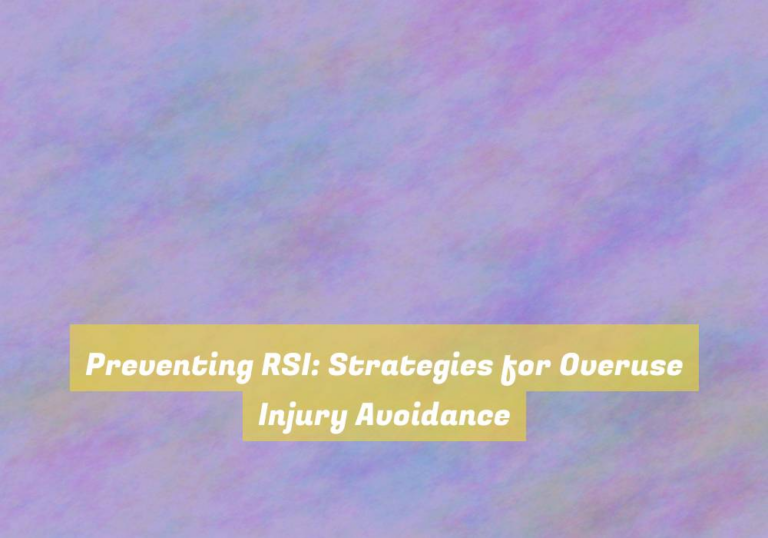Overuse Injuries: How to Optimize Your Recovery
You may not realize that overuse injuries can be just as debilitating as acute injuries, often requiring a different approach to recovery. Have you ever wondered how to optimize your recovery from overuse injuries and get back to your regular activities as quickly and safely as possible?
Understanding the nuances of overuse injuries and the most effective recovery techniques is crucial. ItG??s not just about resting; itG??s about strategic rehabilitation and preventative measures to avoid future injuries.
YouG??ll want to know how to do all that, wonG??t you? Keep reading to discover the best ways to optimize your recovery and get back to doing what you love.
Understanding Overuse Injuries
If you frequently engage in repetitive movements during exercise or work, you may be at risk of developing overuse injuries. These injuries can occur when the same motion is performed repeatedly, causing stress on the muscles, tendons, and joints. Common examples of overuse injuries include tennis elbow, runnerG??s knee, and carpal tunnel syndrome.
Overuse injuries often develop gradually, starting with mild discomfort that can progress to persistent pain. Ignoring these early warning signs and continuing with the same repetitive movements can exacerbate the injury and lead to more severe pain and functional limitations.
Understanding the root causes of overuse injuries is crucial in preventing their occurrence. Factors such as improper technique, inadequate rest periods, and overtraining can contribute to the development of these injuries. ItG??s important to listen to your body and recognize the signs of overuse, such as localized pain, swelling, or decreased range of motion.
Effective Recovery Techniques
To optimize recovery from overuse injuries, implementing effective techniques is essential for healing and preventing further damage.
One of the most crucial techniques is rest. Giving your body time to recover is vital in the healing process. This means taking a break from the activity that caused the injury and allowing the affected area to rest and repair itself.
Additionally, applying ice to the injured area can help reduce inflammation and alleviate pain. Ice therapy can be done several times a day for 15-20 minutes at a time.
Another effective technique is using compression to support the injured area and reduce swelling. Compression bandages or sleeves can help stabilize the injured area and promote healing.
Furthermore, elevation is important in reducing swelling and promoting circulation. Keeping the injured area elevated above the level of the heart can aid in draining excess fluid and reducing inflammation.
Lastly, incorporating gentle stretching and strengthening exercises into your recovery plan can help restore mobility and prevent future injuries.
Preventing Future Injuries
When preventing future injuries, itG??s important to focus on maintaining proper form and technique during physical activities. Whether youG??re lifting weights, running, or playing sports, using correct form can significantly reduce the risk of overuse injuries. Pay attention to your body alignment, movement patterns, and breathing to ensure that youG??re not placing unnecessary stress on your muscles and joints.
Additionally, gradually increasing the intensity and duration of your workouts can help your body adapt and become stronger over time, lowering the likelihood of injury.
Another crucial aspect of injury prevention is incorporating rest and recovery into your routine. Your body needs time to repair and rebuild after physical activity, so make sure to schedule rest days and prioritize sleep. Overtraining and inadequate rest can lead to fatigue, decreased performance, and heightened susceptibility to injuries. Furthermore, diversifying your workouts and cross-training can prevent overuse of specific muscles and reduce the risk of repetitive strain injuries.
Lastly, donG??t overlook the importance of proper nutrition and hydration in injury prevention. Adequate fuel and hydration support muscle function and tissue repair, helping to maintain overall physical resilience. By prioritizing form, rest, diverse training, and proper nutrition, you can significantly reduce the likelihood of future overuse injuries and optimize your long-term physical well-being.
Returning to Physical Activity
After preventing future injuries through proper form, rest, and nutrition, you can now focus on safely returning to physical activity.
ItG??s important to ease back into your routine to avoid re-injury. Start with low-impact activities like walking or swimming before gradually increasing intensity. Listen to your body and donG??t push through pain.
Incorporate dynamic stretching and targeted strengthening exercises to rebuild muscle and improve flexibility. Pay attention to any lingering discomfort and modify your workouts accordingly.
Cross-training can also help prevent overuse of specific muscles and reduce the risk of recurrent injuries. Remember to warm up before exercising and cool down afterward to aid in recovery. Additionally, ensure that youG??re wearing proper footwear and using appropriate equipment for your chosen activity.
If you experience persistent or worsening pain, consult a healthcare professional before resuming full activity. By taking these precautions and gradually reintroducing physical activity, you can minimize the risk of overuse injuries and optimize your recovery.
Conclusion
So, take care of your body, listen to its signals, and use the recovery techniques mentioned to heal from overuse injuries.
By being proactive and patient, you can prevent future injuries and safely return to physical activity.
Remember, your health and well-being are the top priority, so donG??t rush the recovery process.
Stay consistent with your recovery plan and gradually ease back into your exercise routine.
YouG??ve got this!







